To date I have very little information on the Hodgins ancestors. James Hodgins, my great grandfather, was born in Lisburn according to the 1901 census. According to his marriage Certificate his father’s name was Robert, a mechanic. James was a minor so therefore less than 21 (assume 20 or 19?). FMP has a death of James Hodgins, born 1852, so this may be his birth date. The marriage certificate has Jane Hodgins was a witness. James’s mother? Sister? Aunt?
Based on what I can find in the Irish records, I have pieced the following together, as a best guess, for James’s ancestors. I am assuming Hodgin and Hodgins are interchangable.
A marriage took place in Lisburn between Robert Hodgin and a Mary Maguire on 24 December 1849 in the Registry office. They are both from the parish of Blaris, and Mary from townland Knockmore. Robert was 21 years of age and so born c. 1828. His father is listed as Abraham.
In the marriage record, both Abraham and Robert are weavers. Unclear if this Robert is James’s father, although since James was born c. 1853, it is possible. Unsure if mechanic and weaver are both possible occupations.
According to Family Search, Mary’s father was Henry Maguire, and Robert and Mary had a daughter, Selena in 1864, in the workhouse. Selena died that same year, and there is death of a Mary Hodgin, aged 50, in 1864, but no further information. If the age is correct, she would be too old to be Mary born Maguire.
Possible Hodgins family
Lisburn?
An Abraham Hodgin died in 1874, aged 64 or 67 in Lisburn. These dates line up for him being the possible father of Robert (born 1828), although it is not possible to verify. A son Abraham is present.


This corresponds with the death notice below, dated 1874, naming an Abraham Hodgin of Lisburn, also appearing in FMP, giving him a birth date of 1807. Lissue may refer to Lissue House, bought and renovated by the Richardson family in 1855, Linen merchants.
If this IS Robert’s father, we can link him to a brother Abraham, an Uncle, William, and a grandfather, James. A William Hodgin is mentioned in the newspaper in Lisburn in 1832, and as resident in Knockmore, Lisburn in 1829 . It appears that William sold his property in 1830. An Abraham Hodgins was leasing a house in Blaris in 1862, according to FMP. The parishes match up and names are ones that crop up again in the family line, but nothing else found to date verifies the link.

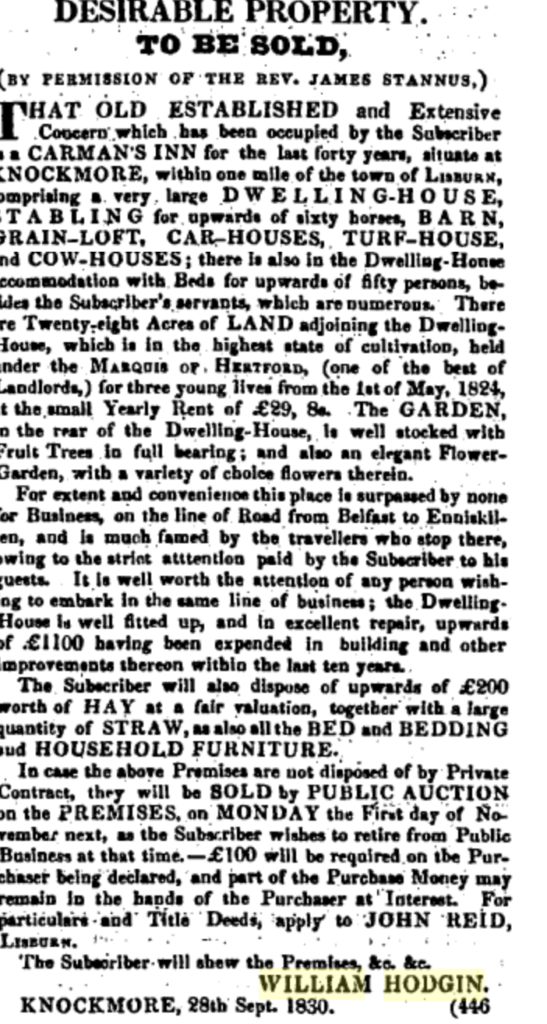
There is also an Abraham Hodgin/Hodgins in the Irish records and census, born around 1845-1847 and described as a Railway Engineer. This Abraham was in the court report in the Belfast newsletter in 1896, having been dismissed from his job as an engine driver, due to a charge of leaving his engine while at a station and of being drunk at the time. He is from Lisburn, and in the 1901 census is living with his wife Eliza in Longstone Street, Lisburn and in 1911 in Westbourne terrace, Lisburn. This Abraham (Abram) married Eliza (born Conn) in 1866.
According to the census Abraham and Eliza had 7 children, 5 living. Daughters Sarah (b.1879) and Jenny (b.1883) are in the census. A daughter Jane, born around 1886 married a Francis Best in 1911 when she was 25 (?), in Lisburn. This may actually be Jenny, as a birth is recorded in 1912 to Jennie Best, born Hodgin. The baby’s name was Abraham Edward Carson Best (!). No need to guess their political persuasion. Agnes Hodgins, who appears to be another daughter, was a witness. Abraham’s wife Eliza died in 1914 and Abraham died in 1921, with daughter Agnes present. As can be seen from the headstone, another daughter, Charlotte died in 1906. According to Family Search she was born in 1874. A son James was born c. 1877 and died in 1883.
It is tempting to think this Abraham was a brother of Robert. (He was not a brother of James as Abraham’s father was Abraham, not Robert). If Robert was born around 1828 and Abraham born 1845 – 17/18 years between is possible.
The Lisburn information consists of ‘dots’ which all look relevant but I do not have any documentation to join them. I have tried to represent them below. My best guess is that Abraham, the son of James is also Abraham the Father of Abraham who married Eliza Conn, and the brother of Robert who married Mary Maguire. It is interesting that Robert seems to disappear after marrying Mary Maguire, who turns up in the workhouse c. 1864. He may have left her and the country, since no further trace appears. And he may not be James’s father.
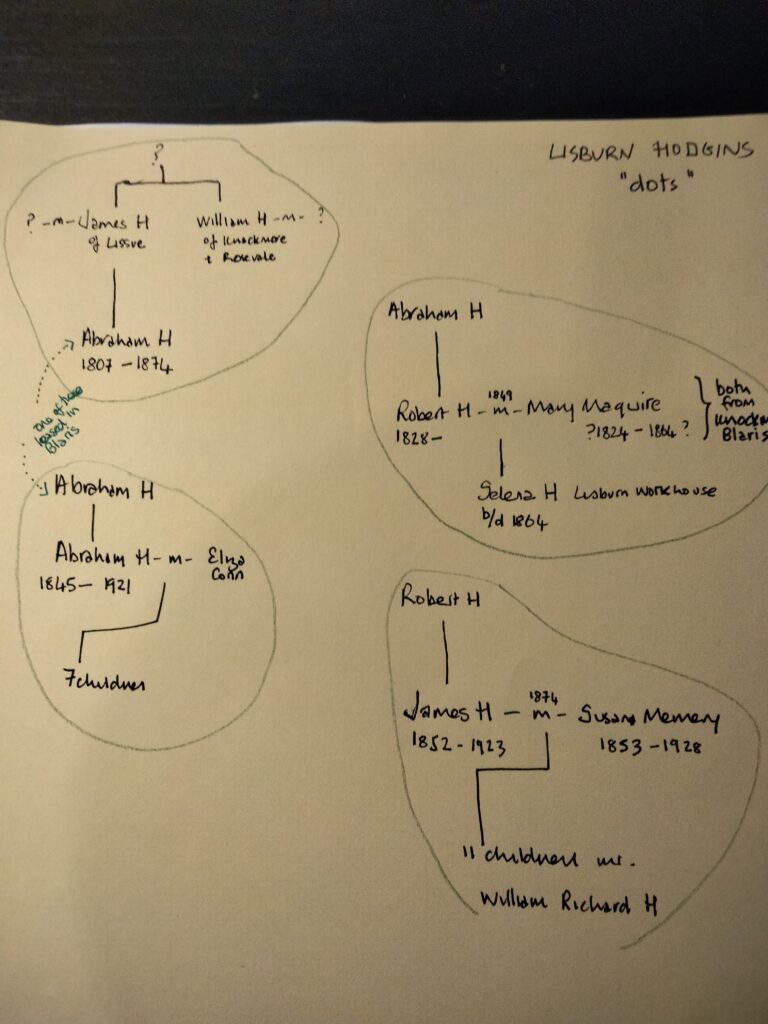
Belfast ?
I think the Belfast Hodgins picture is not our family. I think the Lisburn family is most likely ours .However I have pieced together some of it so put it in here for completeness.
A Robert Hodgins died in 1894 in Nrth Boundary Street in Belfast (see below). He would have been born around 1836, if he was 58, according to the corrected record, as indicated. If the correction is correct, this cannot be the same Robert as Robert who married Mary Maguire in 1849, aged 21. However if he was 65 according to the original record he would have been born in 1829, and it could be that he is the same Robert who married Mary Maguire. He is described as weaver in the death record. However he left a will and in the Wills calendar, he is described as Retired Prison Official. It is unclear why the record was changed, although (other than a genuine mistake) the most likely explanation would be in order to claim a pension or insurance.
A son Abraham was present at death, and another son Samuel, who witnessed the correction. He left a small will with son Samuel the beneficiary. Samuel is described as Storeman.
In 1898, a Samuel Hodgins, Storekeeper, a widower at age 40 and living in Boundary Street, married Hannah Linsey. His father was Robert Hodgins. Robert is described as a Warder. This must be the son Samuel noted in the death record in 1894, who would have been born c. 1858. There was also a Samuel Hodgins who married a Maria Thompson/Bell in 1870, although he was born in 1848, father Robert, a labourer. It is tempting to think this is an earlier marriage for Samuel of Boundary Street, but the age difference is quite large. Either Samuel was very bad on ages, or this is another Robert Hodgins.
An Abraham Hodgins was born in 1871, son of Robert Hodgins a weaver, and Catherine Stirling. An Abraham, described as a sawyers helper, is listed as marrying Agnes Daniel in 1899, son of Robert Hodgins, a weaver. So this may be the other son in the death record, born when Robert was between 35 and 42 years. (IF Robert was the same Robert who married Mary Maguire, Catherine could be a second wife). Abraham is in 1901 census, born c. 1874. In 1907, an Abraham Hodgins, sawyer, who was born in 1873 died. These are probably all the same man. A Catherine Hodgins died in Belfast, address Letitia Street in 1877, aged 31 so b. c. 1838.
An Alice Hodgins was born in 1873, father Robert, mother Catherine ‘Stylen’ Hodgins, In Belfast, according to Family Search. This Alice is another member of Robert of Boundary Street’s family. She married a James Kean in 1893, who was present at the death of Abraham, listed as his brother in Law.
There is an Abraham Hodgins who appears in the Belfast newspaper who owned a premises in Mountjoy Street in Belfast. He signed the Ulster Covenant in 1912, seen below. He was in court in 1911 for allowing intoxicating liquor to be consumed when he shouldnt, was held up at gunpoint by armed raiders in 1921, and he sold this business in 1921. I am unsure where he fits into the Belfast Hodgins. He was born c. 1865. He is in the 1911 census as unmarried.
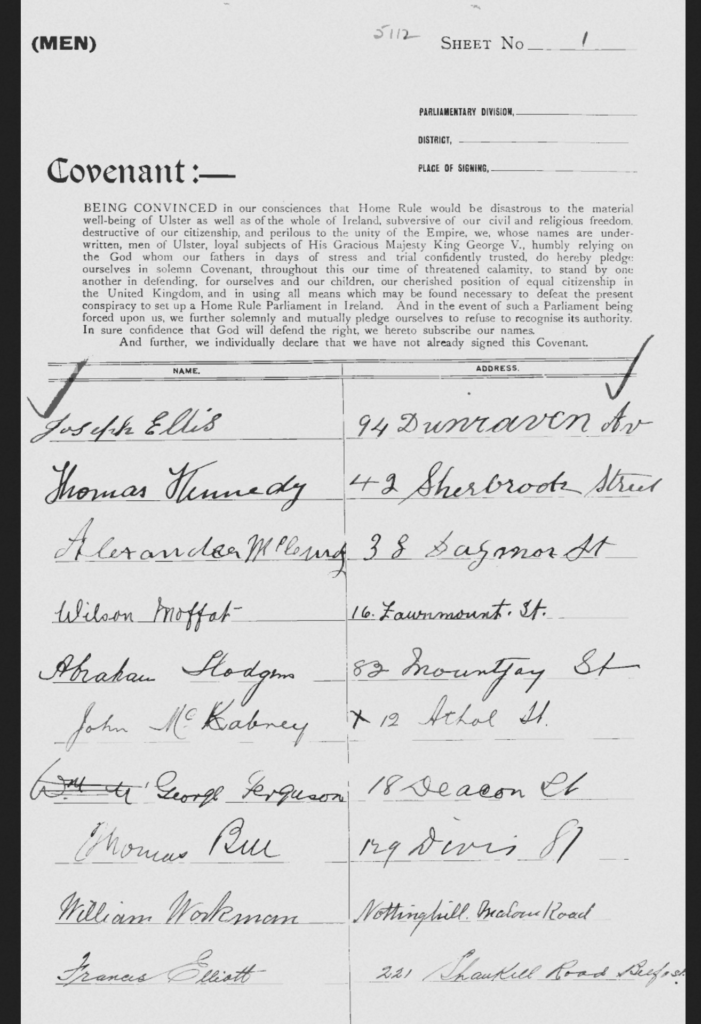


What about Jane Hodgins, the witness at James and Susan’s marriage in 1874? It is most likley she is either his mother, sister, or a sister-in-law. I cannot find any record of a marriage between a Jane and Robert Hodgins.
Jane the daughter of Abraham, the railway inspector, was not born until 1886.
A Jane Hodgins married William Hanson in 1866, her father Robert described as a Bleacher. She was 21, and so born in 1845. This cannot be the Robert married in 1849 as she would too young, nor the Robert born in 1936. And not an Aunt, or her father would be Abraham Hodgins.
A Jane Hodgins unmarried who died in 1873 in the Lisburn Workhouse (born 1816), a Jane Hodgins unmarried died in Enniskillen workhouse, aged 70, (born 1844), a Jane Hodgins, unmarried died in Belfast in 1896, (born around 1844), a Jane Hodgins, unmarried who died of TB, aged 21 in Dublin in 1876,(born 1855). These could be aunt/sisters of James witnessing his marriage in 1874.
But we still don’t know if who James’s father, Robert is. It is not certain if the Belfast Robert who left the will and died in 1894 IS James’s father. Or Robert who married Mary Maguire? Or was there another Robert???? I cannot connect James to Robert beyond James’s marriage Certificate.
Robert who married in 1849 is likely to have had a child each year and I can find no other children of a Robert Hodgin, excepting Selena, which is odd. One would expect several between 1849 and 1864 when Mary died ??. Maybe they all died in the workhouse. Very few survived it. James apparently came to Dublin around 1874 when he married Susan Memery.
The only information I recall being told about the Hodgins family was that William Richard (our grandfather) ran away to sea, and so had his father, James. According to Alison he was a boiler maker.
There was a James Hodgins that was mentioned as attending the Lord Mayor’s Banquet, in The Freemans Journal in 1866, but our James would only have been c. 11 years old then, so unlikely ? Unless James came to Dublin very young. Which he could have done if his parents were in the workhouse ?? But what was he doing at a banquet ? Probably another JH
James Hodgins, G Grandfather
James Hodgins, son of the elusive Robert, married Susan Memery in 1874, sister of Mary Ann Memery who married John Gray. James was born in Lisburn, Susan in Devonshire. A Jane Hodgins was a witness.
James appears to have been in Dublin from at least 1872, as he is listed as crew on the ‘Mary Jane ‘ in that year. James crewed with William Richard Memery and Henry Memery, on the ‘Naomi’ in 1876, with William on the ‘Mary Jane’ in 1872, on the ‘Capella’ in 1899, and skippered the ‘Sea King ‘ in 1896. He may have been in Merchant Navy during the war. He received a medal for service, and he is described as ‘Master’.
A clipping from the Belfast News in 1891 reports how James and fellow Torbay fisherman, George Rowden made a grisly discovery of Howth Head. The Robert Rowden they fished out of the sea was married to Rebecca Memery, daughter of William Richard Memery, Susan Hodgin’s brother. The Freeman’s Journal also reported the incident but reported James as Hudson.
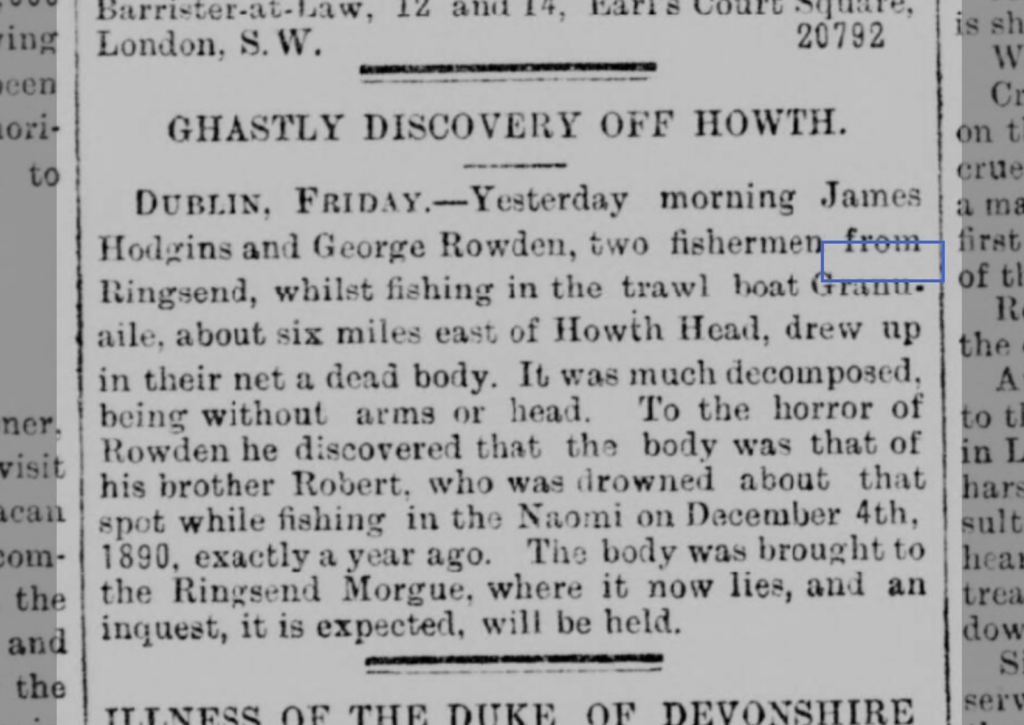
Susan and James are listed in the 1901 census living at 211 Pembroke Cottages, with Jane aged 26 and Henrietta aged 6. James is described as a Fisherman.
There are several entries to the South Dublin Union workhouse for a James Hodgins born 1851/2/4 but they appear to be a different man, listed as single and living in Tallaght. One notes describes him as Catholic. So I don’t think this is our James.
William appears in the census as a student at The Hibernian Marine School.
Susan is listed in the 1911 census living at 100 St Lotts Road, with Jane and Henrietta, both noted as deaf. James and William (Richard) are at sea. James is listed as a Skipper. They are listed as having 11 children in the 1911 census, but only four living, a terrible testament to poor public health and poverty in those times. The 11 are; William Henry b. 1874, Jane b. 1877, James b. 1879, Susan b. 1881, twins Mary and Betsy, b. 1883, Samuel, b. 1885, William Richard b. 1887, Susanna, b. 1889, Henrietta, 1893, Rebecca b. 1895. The four surviving; Jane, Henrietta, William Richard and Mary.
William Henry b. 1874
William Henry died in 1877, 2 years of age.
Jane b. 1878,
Listed in 1911 census. Ken and Wesley both say Janie marred Herbert Gray and their son was Willie Gray who lived beside Willie Hodgins in Finglas in 1915. They married in 1915, according the Irish civil records.
James b. 1879
No death seems to be recorded for James in Irish records, although Family Search has a James Hodgins, born 1878, died 1884, age 6.
Susan b. 1881
Susan died at 4 years. The cause of death is recorded as scarlatina. Lizzie Memery was present at the death, her Aunt. Unsure who she can be. Married to a brother of Susan ? It could be Elizabeth (born Martin) who married William Richard Memery (Uncle to Susan) in 1880.
Twins Mary and Betsy, b. 1883,
Betsy died at one year, of the Scaraltina that carried off her 4 year old sister, Susan.
There is a Mary Hodgins in the 1901 census, aged 17 and servant to a Tierney family in Inns Quay in Dublin. Since Mary is not listed in the family home in the 1901 census I think this may be her. Mr Tierney is listed as a ‘missionary to seamen’, and they are a CoI family. Although I cannot find her in the 1911 census, Mary married William Stewart in 1908 (Harbour Master in Dublin Docks (acc. to George and Dad), and had 3 children, Susie (b.1912), Peggy, and James (b.1910). She later married Stephen Symes, of another Torbay family, who had a daughter Betty from an earlier marriage. This earlier marriage was to Mary’s younger sister, Henrietta, in 1922. James is described as a retired sea captain in their marriage certificate. Stephen and ‘Etta’ ( I remember hearing this name) had twins who died at birth. Etta died in 1928, possibly from TB.

Stephen and Mary lived in 6 The Square. I have a few memories of Aunt Mary. Gran used to call Mary ‘twinnie’. When Mary declined an invitation from Gran to attend a funeral with her, she complained that Mary was ‘no fun’. My memories of Mary are that she was very old and bird-like and had an eye patch which was (to us, as children) kind of spooky. Uncle Stephen always had sweets for us when we visited and shouted at us when we messed up his garden. He worked as a Captain of a tug for the Dublin Port and Docks, and I believe was nicknamed ‘The Admiral’. He is related to Edmund, author of the paper on the Torbays. Stephen was interviewed for a historical project and Ken has this recording.
Samuel, b. 1885
Samuel died at age 4 of scarlet fever.
William Richard b. 1887,
Married Mary Ann Gray
Ken says William went to a school for Mariners, but left after a few months and “ran away” to sea, to the displeasure of his family. This must be the Hibernian Marine School and is consistent with the 1901 census..
The school is now Mount Temple Comprehensive School. Coincidently, The Hibernian Marine School amalgamated with Mountjoy School (where Dad attended) in 1968. William Richard crewed on the SS Kilkenny at 16 years of age and on the ‘Paragon’ in 1917. He was skipper of a ship called the ‘William Castle’ I believe. According to Dad, he wouldn’t skipper after they lost a boy at sea, although he still crewed at times and also worked on and off in Bissets Garage on Irishtown road.
He died in 1945. Agnes told me once that people used to believe the souls of sailors came back as sea gulls. She didn’t believe this of course, but she did hear a sea gull calling in the back garden and she thought it was calling ‘Bill-ie, Bill-ie” ….
We have very few pictures of William Richard Hodgins. Below is one that hung in The Square Irishtown
Susanna, b. 1889.
Susanna died at 6 years of age, of a fever. At this stage they lived in 22 Pembroke Cottages.
Rebecca b. 1895
Rebecca’s death is recorded, at one year. She died of measles. (This is reading like a case study in a public health text book)
Henrietta b. 1893
Henrietta is listed in both the 1901 and the 1911 census, aged 6 and then 17. In the 1911 census she is listed as a waitress. She married Stephen Symes in 1922, aged 28. After she died, Stephen married her sister, Mary, noted above.
James died in 1923, aged 71, with son William Richard present at his death. Susan died in 1928. Her will below, left her estate (almost 1,000 pounds) in equal parts to Mrs Hodgins (Gran), Mrs Stewart (Mary?) , Mrs Gray (Janie ?) and Elizabeth Symes (daughter of Stephen Symes and Etta). They owned the 100 South Road house.
.
William Richard Hodgins and Mary Ann Gray had seven children; Agnes, James (Jimmy), William, George, Susan, Iris and Vivienne. William died in 1945, and Mary Ann, Gran, in 1979. Susan did not survive.
Agnes, the eldest was born in Irishtown Road. Agnes worked in Bewleys in Nrt. Grt George’s Street for many years. When the rest of the family were married, Agnes lived with Gran Hodgins and cared for her in 7 The Square. My memories of Gran at this time were of her sitting almost regally in the armchair by the fire. She often cautioned Agnes while the grandchildren played on the floor to ‘mind their heads on the fender’. She was very particular about making sure clothes were ‘aired’ and not damp, possible a necessary caution in the days when so many children died. She wore a grey coat and a feathery hat with an enormous (I thought as a child) hatpin. When she very old she sat up in bed reading her bible and sometimes singing ‘Abide with me’. She was very strict about not doing anything that constituted work on a Sunday, perhaps part of her Brixham heritage, (Brixham sailors didn’t put out to sea on Sundays). Agnes thought she has a kind of second sight – Gran was very superstitious about having Hyacinths in a house, she maintained they smelt of death, and brought death, and so wouldn’t have them in the house. Silly as it sounds, to this day I will not have hyacinths in the house. Gran was reported to have witnessed a white substance leaving the body of a girl one night, in a shared room, when they were children. The girl had died during the night. She ‘saw’ people, long dead, occasionally in the bedroom when she was old, as related to me by Agnes. She once greatly frightened Agnes, by asking her one evening, when they were sitting in chairs by the fire, if she was going to fetch a cup of tea for her Father. Agnes replied, ‘Mammy, Daddy’s dead this long time, 20 years or so’. Gran replied “No, he’s sitting on the arm of your Chair’. Given her record at seeing things the rest of us couldn’t, Agnes was very alarmed and immediately ran out of the room.
Agnes married Willie Galvin when she was 50. As told to me by Dad, Willie and Agnes dated many years previously but Gran disapproved of a marriage with a catholic and Agnes abided by this. However they met you many times after and eventually Agnes disclosed this to her sisters and brothers, who all said she should marry him. Alison was her bridesmaid and it was a lovely day. We were so happy for Agnes, who was so good to all her nieces and nephews. Alison, Gail and I spent a lot of time down with Agnes, and when Vivienne and Iris took holidays in the summer and stayed in the Square, along with Anne and Caroline Evans, we dubbed it the YWCA. We had chips from ‘Ferraris’ chipper in Ringsend most nights, but not the other chipper in Irishtown (‘Scotchies’) due to Vivienne’s strongly held belief that Scotchy (long dead) had had a dirty neck.
James (my father) was the son of William Richard Hodgins and Mary Ann Gray. He was born in 1921 at 100 South Lotts Road, his Grandmother’s house. He was in the “Life Boys’, the junior section of the Boy’s Brigade
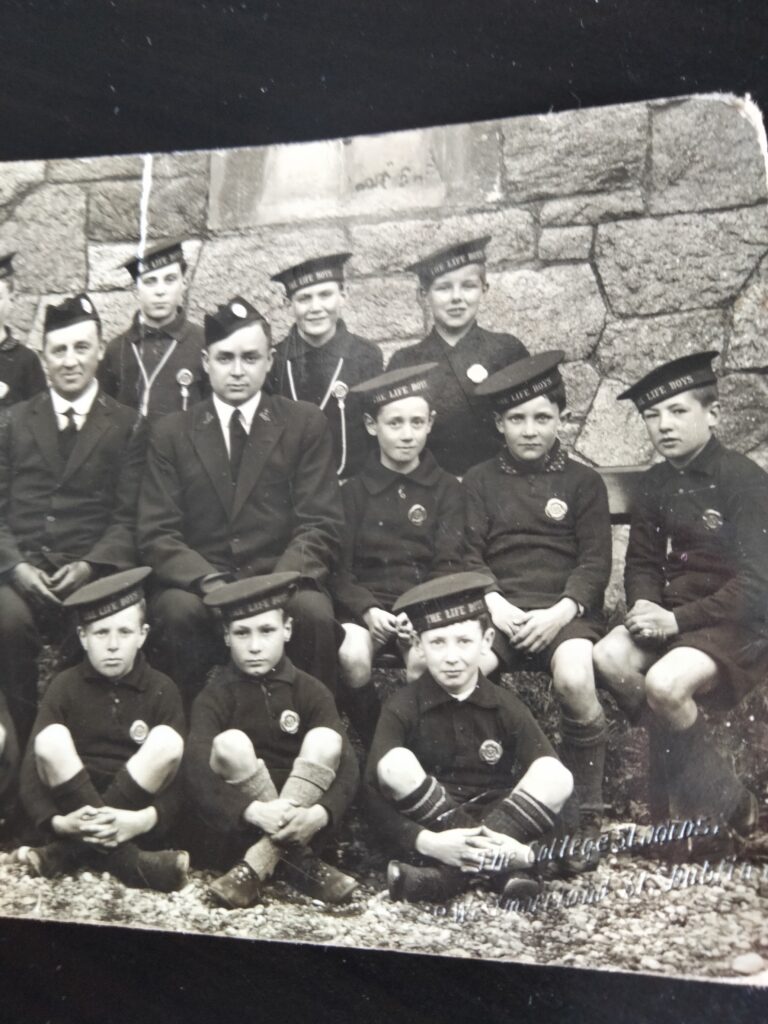
He attended Mountjoy School, and left after his Father died, to work in paint shop in Pearse Street. The picture below was probably taken when he was about 14, and may be of him returning from school. He would have loved to have been a teacher, he told me in later life. Below is part of his School report from 1937.
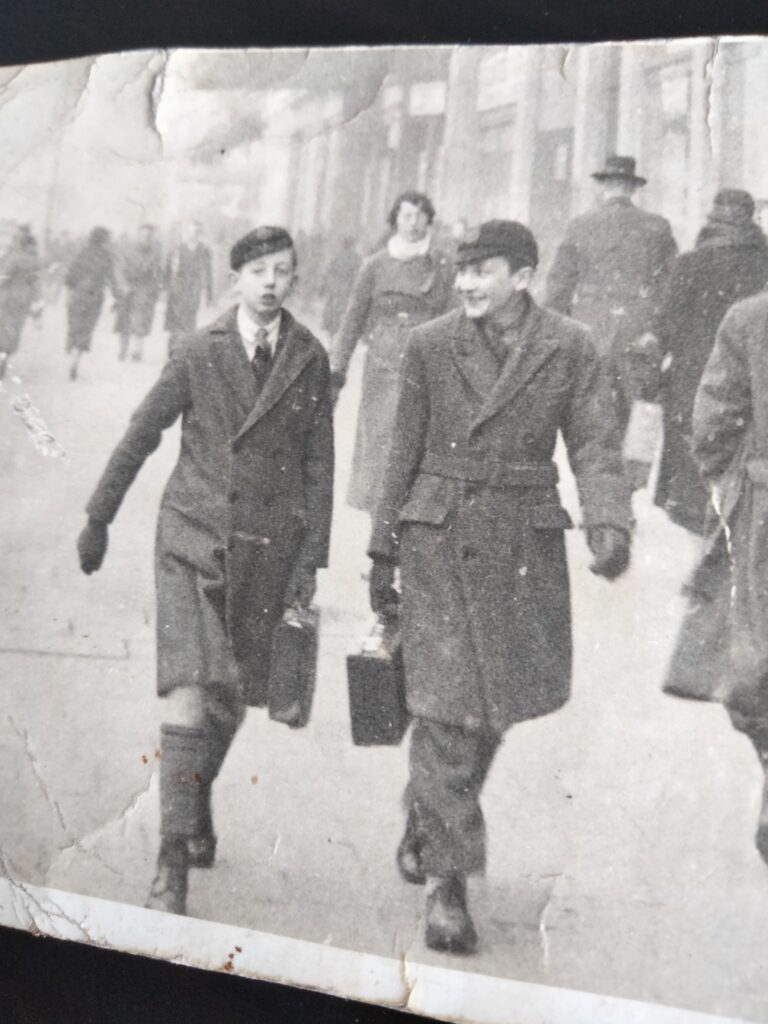
Later he worked for Hammond Lane Foundry, and then Woodhams and Moore Scrap merchants. When Hammond Lane Foundry purchased the “Muirichu’ for scrap, Dad was sent down to Haulbowline in Cork to travel with her up to Dublin on her last voyage. Unfortunately she sank off the coast of Wexford. It was rumoured at the time that the crew had scuppered her, but never proven. All hands were rescued. Agnes told that when it was heard on the radio the next day that the Muirichu had gone down, my Gran exclaimed ‘Oh no I had good blankets on that ship’. Let’s assume she knew her son was safe before she thought about her blankets. The ship is still on the sea bed. It has its place in Irish history having been part of the Clare Island survey and having shelled the custom house during the Rising when it had been commandeered by the of the occupying British forces. Below is a communication from Maritime historian, Tim Collins.
I’ve since just consulted Brunicardi’s book (p. 146-7), and your father is listed as being on the final cruise, along with a delivery crew hired by Hammond Lane, under the command of Capt John Kelly. Your Dad is listed as one of three passengers – Along with a Mr D.J. Flavin also from Hammond Lane, and Brian Inglis of the Irish Times, there to write up the story of the final voyage, later published.
This is part of Brian Inglis’s story
Hearing of the scrap deal from his neighbour, Smyllie assigned Inglis to go to Cobh to sail with the ship on its last voyage back to Dublin. He joined the crew of about a dozen which had been hastily cobbled together and with nourishment from a crate of Jameson whiskey they sailed down the estuary and out to sea. Inglis recalled the voyage in his autobiography Downstart: “Night fell as we reached the open sea. When I woke up the following morning, it was as if the hangover had taken a new and unwelcome form; it felt as if my aching head was hanging below my knees. This was in fact the case: the Muirchu was at an alarming angle, down by the bows. Staggering out on deck, I found the captain (who must have been older than his ship), the mate and the representative of the foundry nervously conferring, wondering what to do next.” The ancient craft had sprung a leak off the coast of Waterford and the front bulkhead was filled with water. It was decided to put the Muirchu into reverse in order to lift the bows and allow that water to flow out.
The manoeuvre succeeded in lifting the bows – but the water, instead of flowing back out to sea, burst through the bulkhead into the engine room, bringing the ship to a halt.
There were some Welsh trawlers fishing nearby and the captain decided to summon assistance. He sounded the standard distress signal, a quick succession of toots on the ship’s siren.
“But”, wrote Inglis, “there was hardly any steam left; the only sound when the captain pulled the cord was a sigh we could barely hear ourselves.” As the Muirchu appeared to be sinking the order was given to abandon ship.
Ten men, including Inglis, were put in the lifeboat and dropped, rather than lowered, into the heavy swell below, as the captain and his two officers had never had to deal with a lifeboat before. They escaped in the ship’s dinghy.
One of the lifeboat’s four oars proved to be rotten and broke when it was used to fend the boat away from the sinking hull. The remaining three were sufficient to row the survivors to within hailing distance of the nearest trawler. “We were not lifted aboard until the crew had some fun at our expense,” said Inglis, “asking each other why they should do anything for the Muirchu, which had chased them when they strayed within the fishing limits.” Inglis and his companions were taken to Milford Haven. The first news to reach The Irish Times was an unconfirmed report that the Muirchu had gone down with all hands. Smyllie immediately repaired to his habitual corner in the Pearl Bar, across the road from the newsroom, to recover from the shock. In the meantime Inglis managed to telephone from Milford Haven his report of the sinking and the rescue.
Dad was a member of the 4th Port Sea Scouts and active in the Maritime Inscription during the Emergency. Below is his travel pass, along with a picture of him, about 18 I would say, with a girl who I think Agnes said was his cousin Rebecca Memery. I have no way now of verifying this. James Hodgins married Phyllis Millington in 1956.
George and Willie were born between Jimmy and the last two girls, Iris and Vivienne. George worked in Hodges Figgis all his working life, starting as ‘the boy’ (or so he told me) and working right up to ‘the boss’. Willie apprenticed as a carpenter and worked in Jacob’s biscuit factory. Willie committed the heinous crime of moving to the north side of the city. Dad used to say in a puzzled voice, ‘I don’t know Why Willie moved over to the North side’, as if it were Siberia. Willie built his own boat, which he moored at Bullock, and fished frequently in the summer months. He fished with Bill Colvin, his wife Jess’s nephew. Jess had TB as a young woman and underwent a highly invasive surgery that I suspect was ‘artificial pneumothorax/partial pneumonectomy’ which was the only treatment for TB before streptomycin was routinely administered. If left the patient with a disfigured back.
Nicknames were common in the family and Agnes and Iris called Jessie Jessbrown. George was called Mac and Willie, Bawler, due to his short temper. Iris was Delia. Jimmy was ‘Jamsie Cardel’. I have no idea why.
They ate fish frequently, as when a catch was in, the sailors went around houses of crew to give them a good choice. Apparently once Gran put her hand in the proffered sack and was nipped by a crab, still alive. Also, she maintained you can tell how fresh the fish is from the brightness of the eyes. Agnes told me George claimed only to like Hake, and so Gran told him every fish was Hake. Dad loved eating fish, although we didn’t have fresh catch in Stillorgan.
Iris was born in Dunlaoire when the family moved in over the Baileys shop (Mary Ann’s sister Mattie and her husband Gilbert Bailey’s shop). Vivienne was born when they moved to The Square. Vivienne was lively and spirited. I was told, one Sunday as they walked to church, Viv realised her slip was showing below her hem, a terribly shameful thing apparently. She slipped the slip off discreetly and handed it to George to put in his pocket. George was even more horrified at the notion of being in church with a slip in his pocket, than Viv was at having it show below her hem. I don’t know whether he went home or persuaded Dad or Willie to mind the offending item.
Vivienne married Victor Hurley of St Lotts road and they lived in London. She came home every summer for about a month, with her boys David and Brian. This was a big event in our summer. We would meet them off the boat, and then all go down to the Square for tea and Dad would take us (the kids) for a drive, presumably to allow the mothers and sisters to have a good old chat away from little ears.
Brian was notorious for getting into trouble or danger. Some evenings Dad or Uncle George brought us all to Blackrock baths (A rare treat; cold water, concrete changing rooms and wire clothes baskets to tear your legs…). While we paddled around at the sides, Brian aimed for the diving boards, including the highest, despite instructions from Viv not to do so. He cut his back once and had to go to Sir Patrick Dunns Hospital. I think he adopted a dog while visiting and tried to keep it in Agnes’s house. Mrs O’Leary lived in 8 The Square and she was famed for not returning items that landed in her garden. Brian was an excellent footballer player but still, Mrs O’Leary claimed quite a few footballs. I wonder what she did with them?
Another highlight of our summer was the Saturday trips to Donabate. Dad would pile us and the Hurleys into the car and we would set up with ‘pucks’ of sandwiches, (Vivienne’s description), bottles of lemonade, and the dog. I remember long days where we saw the tide come and go, ate ice creams, built sandcastles and were in and out of the sea. We’d finish the day with runs up and down the sand dunes at the end of the beach. Then 8 of us back into the smallish car and back to the south side. There were also shorter trips to Sandymount strand on the no. 3 bus and to Powerscourt waterfall.
David and Brian were older than the rest of us, which gave them a certain cachet, reinforced by the fact they lived in London, and could buy their clothes in places like Carnaby street, like the Beatles. Or so we thought. So trendy, so cool.
